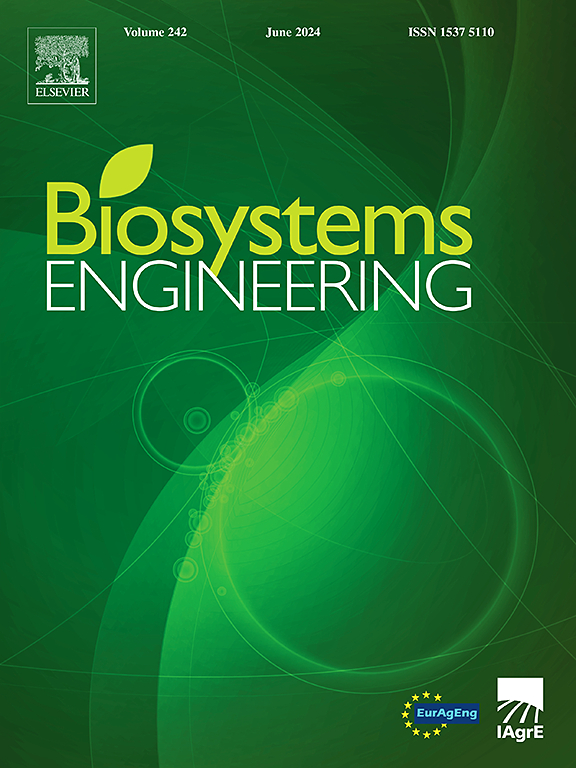工业水产养殖中鱼类摄食行为识别的多模态知识精馏框架
IF 5.3
1区 农林科学
Q1 AGRICULTURAL ENGINEERING
引用次数: 0
摘要
基于机器视觉的鱼类摄食行为识别在工业化水产养殖中具有重要意义。在实际的工业化养殖中,由于饵料阶段存在水体浑浊、重叠等问题,准确、低成本的饵料行为识别成为一项挑战。针对这些问题,提出了一种基于多模态融合和增强知识蒸馏的多模态知识蒸馏识别(MMKDR)框架,以实现低复杂度和低成本部署。具体来说,我们利用ConvNeXt-T的特征提取模块(CNXFE)从视频流中提取图像特征。然后,设计了改进的多模态融合(IMF)模块来生成融合特征,该融合特征可以动态调整图像和水质特征的权重;其次,设计轻量级摄食强度分类(LFIC)模块,根据融合特征预测鱼类摄食强度,有助于优化摄食策略,降低养殖管理成本。为了将学生模型部署到低成本的嵌入式设备上,我们进一步降低了CNXFE和IMF的参数,得到了参数为2.49M的更小的学生模型。提出了一种基于半监督域自适应的增强知识蒸馏(EKD)方案,以实现知识转移,同时提高识别精度。降低设备和数据标注成本,促进低成本低碳养殖。我们在真实的工业养殖环境中对MMKDR进行了实验和评价。结果表明,学生模型在测试集上的准确率为96.65%,在实际工业养殖场景中使用低成本嵌入式设备的准确率为91.36%。本文章由计算机程序翻译,如有差异,请以英文原文为准。
Multimodal knowledge distillation framework for fish feeding behaviour recognition in industrial aquaculture
Fish feeding behaviour recognition based on machine vision has great significance in industrial aquaculture. Due to the problems of turbid water and overlapping fish during the feeding stage, accurate and low-cost feeding behaviour recognition becomes challenging in actual industrial aquaculture. To address these issues, a novel Multimodal Knowledge Distillation Recognition (MMKDR) framework, based on multimodal fusion and enhanced knowledge distillation, is proposed, to achieve low-complexity and low-cost deployment. Specifically, we utilised the Feature Extraction module of ConvNeXt-T (CNXFE) to extract image features from video streaming. Then, an Improved Multimodal Fusion (IMF) module is designed to generate the fused feature, which can dynamically adjust the weights of the image and water quality features. Next, a Lightweight Feeding Intensity Classification (LFIC) module is designed to predict the fish feeding intensity from the fused feature, which helps to optimise feeding strategies and reduce aquaculture management cost. To deploy the student model on low-cost embedded devices, we further reduce the parameters of the CNXFE and IMF, and obtain the smaller student model with 2.49M parameters. An Enhanced Knowledge Distillation (EKD) scheme, with semi-supervised domain adaptation, is present to achieve knowledge transfer with better recognition accuracy. It can reduce devices and data annotation costs to promote low-cost and low-carbon aquaculture. We carried out experiments and evaluated MMKDR in a real industrial aquaculture environment. The results demonstrated that the student model achieved an accuracy of 96.65 % on the testing set, and an accuracy of 91.36 % using low-cost embedded device in real industrial aquaculture scenarios.
求助全文
通过发布文献求助,成功后即可免费获取论文全文。
去求助
来源期刊

Biosystems Engineering
农林科学-农业工程
CiteScore
10.60
自引率
7.80%
发文量
239
审稿时长
53 days
期刊介绍:
Biosystems Engineering publishes research in engineering and the physical sciences that represent advances in understanding or modelling of the performance of biological systems for sustainable developments in land use and the environment, agriculture and amenity, bioproduction processes and the food chain. The subject matter of the journal reflects the wide range and interdisciplinary nature of research in engineering for biological systems.
 求助内容:
求助内容: 应助结果提醒方式:
应助结果提醒方式:


